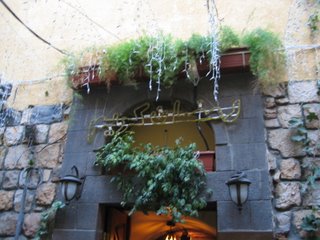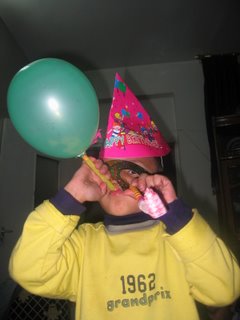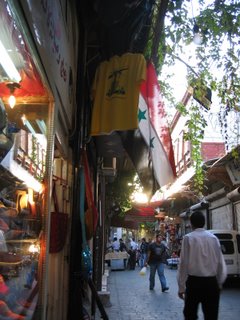Reflections on Ramadan
 Ramadan light decorations ("Ramadan Kareem" they say, Honorable Ramadan).
Ramadan light decorations ("Ramadan Kareem" they say, Honorable Ramadan).Now that I have experienced Ramadan in the Middle East I thought I should describe what it’s all about here. Ramadan is, of course, the month in which Muslims fast from sunrise to sunset as an expression of submitting the body and mind to God’s will. Each night, family and friends get together to break the fast, called iftaar, from the word for breakfast (interestingly, the English term for breakfast has the same semantic root, in that we break the fast each morning from the previous evening’s sleep). This year iftaar fell between 5:30 and 5:00 p.m. I was lucky to have the pleasure of breaking the fast with both local families and groups of friends.
Damascus, the usually bustling capital city, has a different rhythm during Ramadan. The streets are still crowded with cars and pedestrians during the day, but come 4:00 p.m. the streets, alleyways, and sidewalks start to empty as everyone rushes home to eat. At 4:45 or 5:00 p.m., you could take a stroll around the city and not see one car drive by or person walking the sidewalk. The city becomes a near ghost town. If you peek into the few shops that still have workers in them you will usually see a quiet group sitting around eating together, too focused on the meal to worry about talking. This tranquil atmosphere is a great feature of Ramadan: it is one of the few times Damascus goes quiet.
 Sharing iftaar outside a shop.
Sharing iftaar outside a shop.One of the nicest rituals in my Ramadan experience was breaking the fast with the shopkeepers in the souq. Each night, they would order food from a nearby restaurant in the Old City (alternating their patronage between different restaurants), and one of the boys would go to pick it up. Another might run to buy a stack of Arabic bread from a bakery stall. I learned a lot about the good local restaurants this month and about the names of many Arabic foods I wasn’t familiar with. There are, of course, the traditional favorites like kebseh (roasted chicken on seasoned rice), baamiya (okra with lamb in tomato sauce), and fetteh (bread and chickpeas in yogurt sauce), but I also got to try many soups and meat dishes that I had never ordered before. All of these main dishes are accompanied by the usual mezze fair that many Americans are familiar with from Turkish or Middle Eastern restaurants in the U.S. such as hummus and baba ganoush. A large tray would be laid out on a stool so that everyone can pull up a chair around it. In the Arabic style, everybody eats off the same serving plates, scooping up food with a piece of bread or spoon.
Since I wasn’t part of the planning process for dinner, I usually brought along some baklawa or other bakery goods for an after-dinner treat. Early on in my stay here (since Ramadan started only a week after I arrived), my contributions to the dinner table would often be chastised by my hosts because of their sense of Arab hospitality and honor (“Why did you bring sweets? We already have sweets of our own!”). Fortunately, I knew I was becoming a staple in their social life when they started to accept my attempts at reciprocity without question.
A sometimes frustrating aspect of Ramadan is that productivity comes to a near standstill. I was unlucky enough to be looking for a house during this holiday season, and I had to wait weeks for a house that I found that I was originally told would be ready in one week, which turned into three before the finishing touches on the renovations were completed.
And don’t think that Ramadan ends with the last day of fasting. This week is Eid, the holiday celebrating the completion of Ramadan. Although the fast is over, this week is a national holiday and most workplaces and businesses are closed. I took my pants to the cleaners on Satuday and didn’t have time to pick them up the next day, which means they were stuck in the cleaners' for the week until Eid ended. But Friday is also a weekend day here, and many shops remain closed for the Muslim day of communal prayer. My pants were at a cleaners’ shop in Bab Touma, a Christian area, so all I could do was hope that a Christian runs the shop and would open Friday to reclaim my treasured jeans and khakis. As it happened, the shop didn't open til Saturday. With Damascus so multi-colored religiously, it is impossible to predict store hours. The owner could be a Christian who takes Saturday and Sunday as his weekend, or he could follow the national and Muslim practice of taking Friday and Saturday off, or he could be a true businessman and remain open both Friday and Saturday. In the end, it sometimes feels that a month of low productivity is followed by a week of zero productivity. We Americans are unaccustomed to allowing ourselves weeks on end of mere visits and socialization. Particularly as a researcher, I sometimes feel that my research is floundering because there are no time commitments during Ramadan. I try to comfort myself with the knowledge that I am supposed to be following the rhythm and flow of life here, not to change it and make appointments of my own.
 Plenty of new toys to enjoy during Eid (no matter that this set is meant for a birthday).
Plenty of new toys to enjoy during Eid (no matter that this set is meant for a birthday).In other ways, Eid is reminiscent of Christmas in the U.S. First, of course, there is the week off of school and work. Second, kids and youth roam the streets wearing fresh new clothes. For the youth, one might say that Eid is a time for checking each other out and showing off for each other their attractiveness. Sequined and bedazzled hijabs adorn women all over the city, and some (Christian) girls break out their short skirts for the holiday break. Children receive gifts and sometimes money, so that the few shops that you will see open in the souq are selling toys and fireworks for kids. Makeshift amusement parks pop up in each neighborhood, with swings, mini ferris wheels, and merry-go-rounds operated by the muscle of young men. All in all, it is a time to reaffirm social connections in a society where such connections are already strong and constantly maintained through visits and hospitality. Many of the foreign students take Eid as an opportunity to travel within and without the country while they are off school. But interestingly, for the locals, Eid is about seeing more of the people they see every day.

Makeshift "amusement park" in Bab as-Salaam, Old City.







